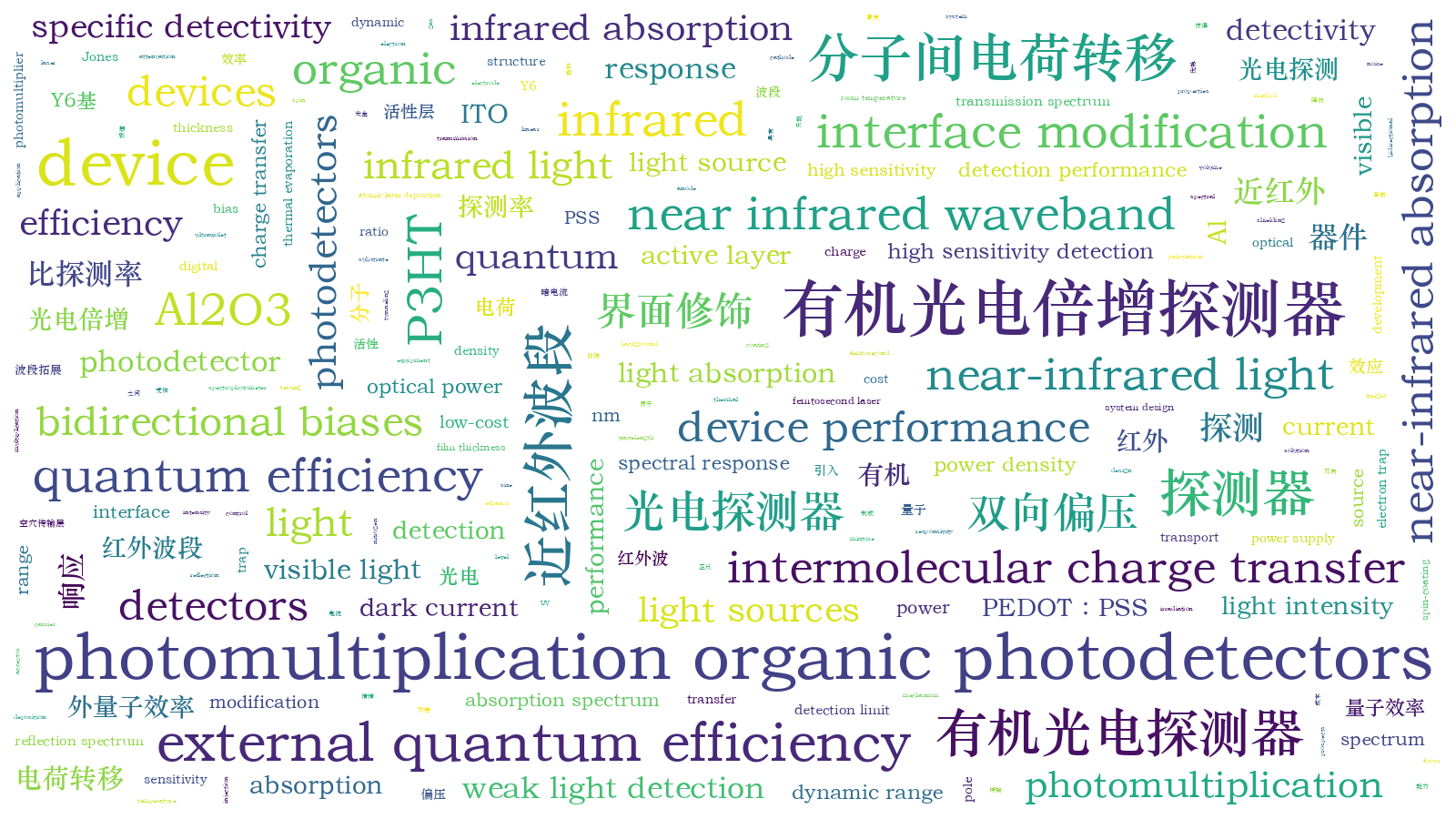基于分子间电荷转移效应的P3HT∶Y6基可近红外响应有机光电倍增探测器
The photomultiplication organic photodetector based on trap-assisted carrier tunneling mechanism not only has high sensitivity but also simplifies system design and effectively improves the weak light detection performance of the photodetector. At present, photomultiplication organic photodetectors mainly focus on the visible range and have relatively few responses in the near-infrared region. Detection in the near-infrared region has broad application prospects in many fields and the demand is becoming increasingly urgent. Intermolecular charge transfer is a low-cost method for achieving near-infrared absorption in organic photomultiplier detectors, which can effectively expand the response band of devices. However, the absorption is low and the response is very weak at long wavelengths. The photomultiplication type devices can amplify weak photocurrent signals and improve device performance. Therefore, by introducing a small amount of organic acceptor Y6 in the P3HT active layer, we fabricate a photomultiplication type organic photodetector. Due to the intermolecular charge transfer between P3HT and Y6, the response band of the device can be extended to 1310 nm, which is superior to the reported near-infrared multiplication type organic photodetectors. By introducing an atomic level thickness of Al2O3 between the hole transport layer and the active layer, the device can work under both positive and negative biases. The external quantum efficiency of the device at 860 nm reaches 800%, with a detectivity of 5.6×1011 Jones. The external quantum efficiency of the device at 1310 nm reaches 80.4%, and the specific detectivity reaches 5.13×1010 Jones. This work can promote the development of near-infrared photomultiplication organic photodetector.
Firstly, the cleaned ITO substrates are dried by nitrogen gas and transferred to a glove box. PEDOT∶PSS is diluted with anhydrous ethanol in a volume ratio of 1∶9 and is span-coated onto the ITO substrate to form a hole transport layer. Then, the Al2O3 interface modification layer is deposited by atomic layer deposition equipment. Subsequently, the active layer is formed by spin-coating P3HT∶Y6 mixture solution, with a P3HT and Y6 ratio of 100∶1 in weight. Finally, the Al electrode is deposited on the active layer by thermal evaporation. The bright and dark currents of the device are obtained by a digital source meter Keithley 2400 and different light sources in a sealed and room temperature state. The testing of external quantum efficiency and responsiveness is performed in a dark shielding box, with ITO as the anode connecting to the positive pole of the power supply and Al as the cathode connecting to the negative pole. The digital source meter Keithley 2400 is adopted to apply different voltages, and a femtosecond laser is utilized as the light source. The light intensity is attenuated to a specified size by an attenuation plate, and the dark current and bright state J-V curves under different light sources are collected. Finally, the external quantum efficiency and responsivity data are obtained through calculation (the data has been background deducted). The linear dynamic range, noise current, and specific detection rate of the device are tested, and the performance of the device is comprehensively analyzed. A spectrophotometer instrument is leveraged to characterize the ultraviolet visible near-infrared absorption spectrum. In addition, the transmission spectrum, reflection spectrum, and film thickness of the device are also tested.
Al2O3 modified device with a structure of ITO/PEDOT∶PSS/Al2O3/P3HT∶Y6 (100∶1)/Al and a control device without Al2O3 are both fabricated. We verify that the Al2O3 interface modification layer can greatly reduce the dark current of the device and enable the device to achieve bidirectional bias response (Fig. 1). Next, the Al2O3 modified device is characterized, and the device can respond to 1310 nm. The weak light detection limit of the device at 505 nm can reach 7.8 nW/cm2. When the optical power density is 3.8×10-4 mW/cm2, the external quantum efficiency of the device at 860 nm is 800%, with a specific detectivity of 5.6×1011 Jones. When the optical power density is 3.67×10-2 mW/cm2, the external quantum efficiency of the device at 1310 nm is 80.4%, with a specific detectivity of 5.13×1010 Jones. Under the irradiation of visible light at 505 nm and near-infrared light at 860 nm, the device has a dynamic range of over 125 dB and 90 dB, respectively (Fig. 2 and Fig. 3). The comprehensive performance of the device has certain advantages compared to the near-infrared organic photomultiplier detectors prepared in recent years. By introducing an organic receptor Y6 with light absorption ability in the near-infrared region, the device effectively promotes the injection of holes from external currents as an electron trap and interacts with P3HT, expanding the corresponding band and achieving high sensitivity detection in the near-infrared region (Fig. 4).
A low-cost and highly sensitive near-infrared photomultiplication organic photodetector with a structure of ITO/PEDOT∶PSS/Al2O3/P3HT∶Y6/Al is reported. By adding Al2O3 as an interface modification layer, the dark current of the device is significantly reduced, resulting in a device that can respond in both forward and reverse bias directions. Adding a small amount of Y6 to the active layer can achieve a wide spectral response from UV visible to near-infrared, and the response wavelength can be extended to 1310 nm. The external quantum efficiency of the device at 860 nm reaches 800%, with a specific detectivity of 5.6×1011 Jones. The external quantum efficiency of the device at 1310 nm reaches 80.4%, and the specific detectivity reaches 5.13×1010 Jones. These properties have certain advantages in reported near-infrared photomultiplication organic photodetector and can promote the development of near-infrared photomultiplication organic photodetectors.
胡依凡, 滑羽璐, 冀婷, 石林林, 崔艳霞, 李国辉. 基于分子间电荷转移效应的P3HT∶Y6基可近红外响应有机光电倍增探测器[J]. 光学学报, 2024, 44(4): 0404001. Yifan Hu, Yulu Hua, Ting Ji, Linlin Shi, Yanxia Cui, Guohui Li. P3HT∶Y6-Based Near-Infrared Organic Photomultiplication Photodetectors by Intermolecular Charge Transfer Effects[J]. Acta Optica Sinica, 2024, 44(4): 0404001.







